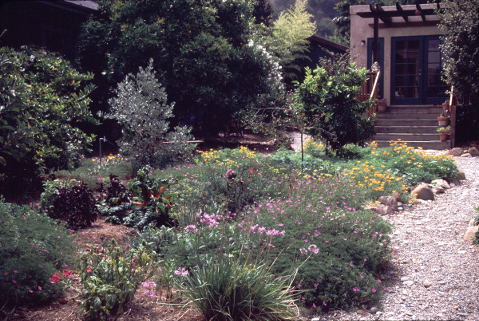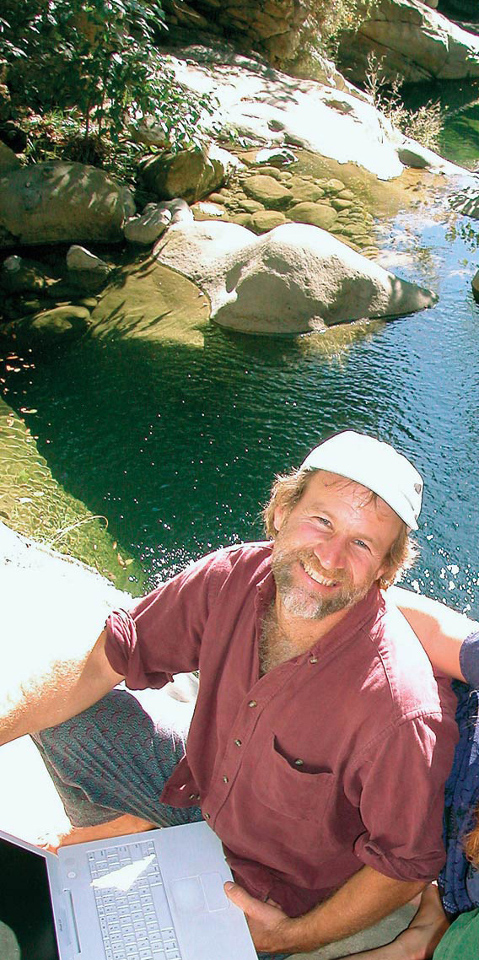When It Rains,
Let’s Make Better Use of It
Green Infrastructure Can Conserve Rainfall
and Balance the Water Budget

Solving a problem in isolation tends to have bad side effects. Water supply is surely important right now, and the ocean looks like a lot of water. This, unfortunately, is a mirage. In energy terms, the ocean at our feet is about as far away as the Yukon; in other words, constructing a pipeline to get water from the Yukon costs less than desalinating water for the city’s population. “Solving” supply with desal takes so much energy it compounds climate change, exacerbating future droughts. It is so expensive, when rains return, it will be tempting to open the gates to high-end development to help pay for the idle plant. More development, of course, will make it tougher to balance the water budget when the next drought comes — unless we expand the desal plant …
This downward spiral could be called the “State Water Effect.” (Advertised cost: $270 million. Actual cost: $1.76 billion. Growth induced: One percent of promised supply per year. Water delivery during drought: zero.) Or the desal effect: Cost in 1990s: $34 million; water delivered when needed: zero.
Looking beyond desal to other potential water sources, what Los Angeles has found is that to address interconnected problems with attention to the big picture tends to have extremely good side effects. Los Angeles has become an emerging leader in collaboration among certain departments. The city is realizing more benefits by considering all the relevant factors at once among and between the departments of too much water (flood control), not enough water (water resources), and too much mulch (solid waste).
For example, Los Angeles’ Department of Water and Power estimates that improving rain infiltration there could supply a significant fraction of the city’s water needs. (This is arguably the biggest omission from Santa Barbara’s water supply modeling, though adding it is under discussion. A modest pilot project could provide the data needed to assess how much this practice could help balance our water budget.) The beneficial side effects also include more and cleaner dry season creek flow, reduced pressure on landfills, less air pollution, reduced flooding, increased soil fertility, and reduced climate disruption. A solution like this only comes about with collaboration.

Santa Barbara’s specialized departments do an excellent job managing resources. So good, there’s not much room for doing better within a given department. Most of the potential for doing better will come from coordinating across departments and disciplines, and with us, the citizens.
On many properties, as much rain falls on the soil as is imported through water meters. Currently, much of this runs off. Some of this water can be infiltrated and stored in soil for later use by plants, recharging groundwater, and feeding local creeks. The potential is large; the South Coast could probably gain as much useful supply from rainwater infiltration as the proposed desalination plant, but with positive side effects.
You can follow the same integration principles in your yard. For example, if you are not on a steep or unstable slope, you can convert ornamental lawn into rainwater-capturing mulch basins, native plants, and fruit trees. This changes a water liability into a water asset for yourself, as well as the community. Effective capture of rain water can delay the need to start irrigation in the spring, make it possible to stop irrigating with the first small rains of fall, and eliminate the need for any supplemental irrigation in the winter.
Mulched infitration basins are also perfect for breaking down yard waste that is too thick for compost and too thin for firewood, reclaiming nutrients and storing carbon. Mulched basins are ideal for receiving household grey water for irrigation of fruit trees, changing another water liability into an asset.
In the heat of desperation during the last drought, we locked ourselves into what turned out to be a very expensive bill for an idle desalination plant. On the other hand, the investment in water conservation turned out to be a gift that kept on giving. Demand today is still lower than in the 1980s, despite population growth.

Ornamental lawns are our most marginal use of water. Desalination is the most marginal supply. Without the one, we’d have a lot less need for the other. Watering a front lawn with 100 percent desal water would cost about $1,000 a year. (The effect of desal on actual water rates is being calculated now.) The best effect of a desalination plant might be the long-term conservation choices spurred by the rate increases that are bound to come. It would be great if we could just do the conservation and skip the cost of the desalination plant.
Local Author Art Ludwig will be giving a series of lectures and workshops on “Water and Integrated Design.” The first, on integrated design for drought, flood, fire, climate, and more is Tuesday, September 30, 6-7:30 pm, at the Faulkner Gallery, Santa Barbara Central Library. More info at oasisdesign.net/education/sb.



